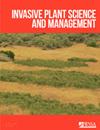纽约多年生燕草的南方枯萎病
IF 1.2
4区 生物学
Q3 PLANT SCIENCES
引用次数: 1
摘要
摘要:浅燕尾草[Vincetoxicum roscium(Kleopow)Barbar.;syn.:Cynanchum roscium。由真菌Athelia rolfsii(Curzi)C.C.Tu和Kimbr引起的V.roscium南部枯萎病。据报道,2008年在纽约县的一个公园里,导致了V.roscium林分的减少。该病的爆发和病原体的持久性突出了A.rolfsii对Vincetoxicum spp.的控制潜力。为了更好地描述A.rolfsii的致病性和生物学特性,我们研究了对成年文氏菌的毒力、发现地4年以上南疫病流行的时空属性和2年以上的菌核存活率。在喷雾室实验中,两种文氏菌都有很高的发病率和严重程度。苜蓿南疫病的时空传播模式表明,在监测的第一年(2016年),该流行病已经高度聚集,随后的传播受到限制,并导致显著的局部聚集。在两个地点(Pittsford和Ithaca,NY)进行的菌核存活研究表明,A.rolfsii分离株可以在纽约州北部越冬,并对Vincetoxicum spp.具有致病性。然而,与放置在土壤表面相比,菌核的浅埋会更快地降低存活率。由于这种病原体通常与亚热带和热带地区有关,因此A.rolfsii菌核病在纽约的越冬期是值得注意的。病原体的广播应用将需要在一个地点进行广泛的Vincetoxicum控制,但即使限制在选定地点的释放也无法阻止病原体通过水或机械转移到场外。在自然和农业环境中,A.rolfsii分离株对其他阔叶植物的已知风险表明,用于Vincetoxicum spp.的生物防治的可行性很低。本文章由计算机程序翻译,如有差异,请以英文原文为准。
Southern blight of perennial swallowwort (Vincetoxicum spp.) in New York
Abstract Pale swallowwort [Vincetoxicum rossicum (Kleopow) Barbar.; syn.: Cynanchum rossicum (Kleopow) Borhidi] and black swallowwort [Vincetoxicum nigrum (L.) Moench; syn.: Cynanchum louiseae Kartesz & Gandhi] are invasive perennial viny milkweeds that have become prevalent across natural and managed habitats in northeastern North America. Southern blight of V. rossicum caused by the fungus Athelia rolfsii (Curzi) C. C. Tu & Kimbr. was reported at a New York county park in 2008, resulting in a decline in V. rossicum stands. The disease outbreak and persistence of the pathogen highlighted the potential of A. rolfsii for Vincetoxicum spp. control. To better characterize A. rolfsii's pathogenicity and biology, we studied virulence to adult Vincetoxicum spp., spatiotemporal attributes of the Southern blight epidemic at the discovery site over 4 yr, and sclerotial survival over 2 yr. Disease incidence and severity were high for both Vincetoxicum spp. in misting chamber experiments. The spatiotemporal spread patterns of Southern blight in V. rossicum suggest the epidemic in the first year of monitoring (2016) was already highly aggregated and that subsequent spread was limited and resulted in significant local aggregation. Sclerotial survival studies at two locations (Pittsford and Ithaca, NY) demonstrated the A. rolfsii isolates can overwinter in upstate New York and are pathogenic to Vincetoxicum spp. the subsequent season. However, shallow burial of sclerotia more rapidly reduced survival compared with placement on the soil surface. Overwinter survival of A. rolfsii sclerotia in New York is notable, as this pathogen is typically associated with subtropical and tropical regions. Broadcast applications of the pathogen would be needed for widespread Vincetoxicum control at a site, but even restricting releases to select locations would not prevent pathogen movement off-site via water or machinery. The known risks of the A. rolfsii isolate to other broadleaf plants in natural and agricultural settings suggest a low feasibility of use for the biological control of Vincetoxicum spp.
求助全文
通过发布文献求助,成功后即可免费获取论文全文。
去求助
来源期刊

Invasive Plant Science and Management
PLANT SCIENCES-
CiteScore
2.20
自引率
9.10%
发文量
24
审稿时长
6-12 weeks
期刊介绍:
Invasive Plant Science and Management (IPSM) is an online peer-reviewed journal focusing on fundamental and applied research on invasive plant biology, ecology, management, and restoration of invaded non-crop areas, and on other aspects relevant to invasive species, including educational activities and policy issues. Topics include the biology and ecology of invasive plants in rangeland, prairie, pasture, wildland, forestry, riparian, wetland, aquatic, recreational, rights-of-ways, and other non-crop (parks, preserves, natural areas) settings; genetics of invasive plants; social, ecological, and economic impacts of invasive plants and their management; design, efficacy, and integration of control tools; land restoration and rehabilitation; effects of management on soil, air, water, and wildlife; education, extension, and outreach methods and resources; technology and product reports; mapping and remote sensing, inventory and monitoring; technology transfer tools; case study reports; and regulatory issues.
 求助内容:
求助内容: 应助结果提醒方式:
应助结果提醒方式:


